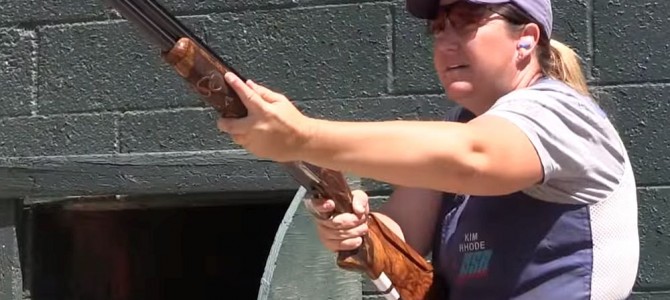
You might not think of Norman Rockwell as the artist of American “gun culture.” Maybe you should. Of the nearly 4,000 images in the “Definitive Catalogue” of Rockwell’s works, about 96 include guns. That’s only a little more than 2 percent of the total number, but I don’t think 100 pictures of guns is anything to wave off.
More important than the numbers, however, is the ordinariness of the guns in the art. They’re just part of life: commonplace things to have around. Let me give you a simple example of what I mean.
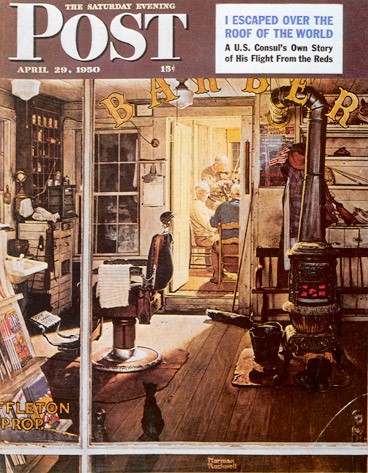
If you look on the shelf behind the stovepipe, you’ll see the butt end of a shotgun. This barber apparently enjoys jamming with his buddies after work, but also enjoys going out after the rabbits and pheasants and such. So there’s his gun, right there in his shop.
You don’t see a lot of that anymore. My own barber has a shop quite similar to Shuffleton’s—but no guns visibly displayed. I wish there were! One of the only non-gun-related businesses I’ve been into where a gun has been easily visible was our lawyer’s office, when we closed on our home. He had a nice AR-15 leaning up against a file cabinet.
I actually mentioned it to him: something like “that’s great that you get to bring your rifle to work.” He told me it wasn’t his gun, he was holding it for a friend who was out of town. Fifty years ago, it’s doubtful that a rifle in a professional’s office would have prompted any comment at all. Rockwell doesn’t hesitate to put them there, such as in this one (granted, it’s just a wall hanger, but there it is):
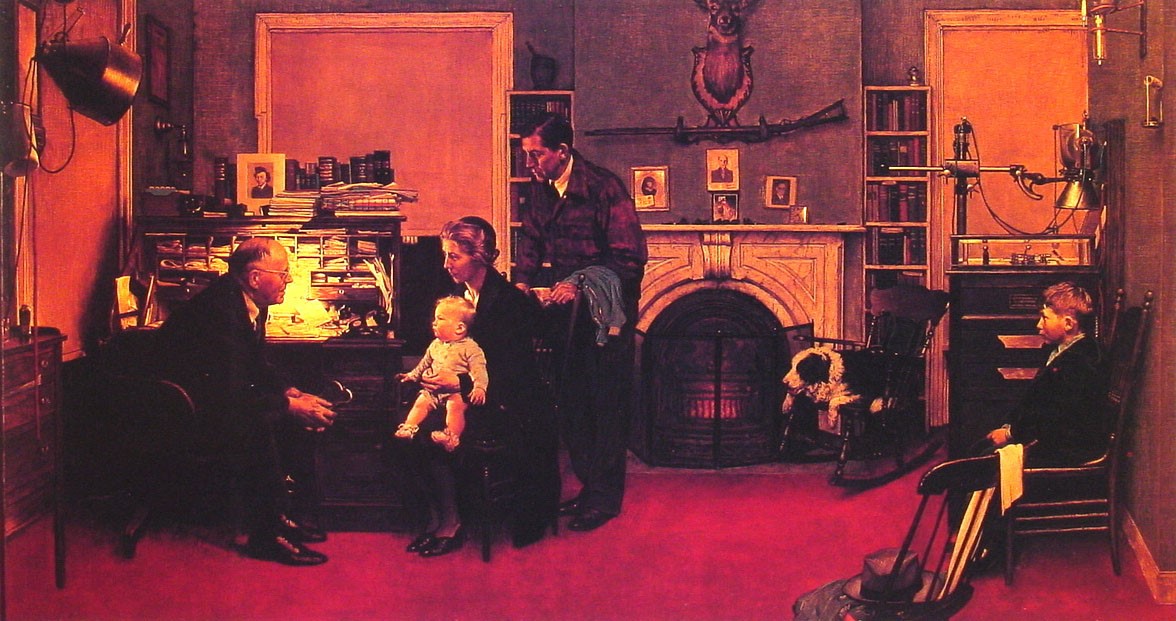
Now, not all the guns in Rockwell’s work are just lying around. Some are in active use, mostly for hunting purposes, but in some cases, gun are used in less lighthearted ways. Here’s one of them.
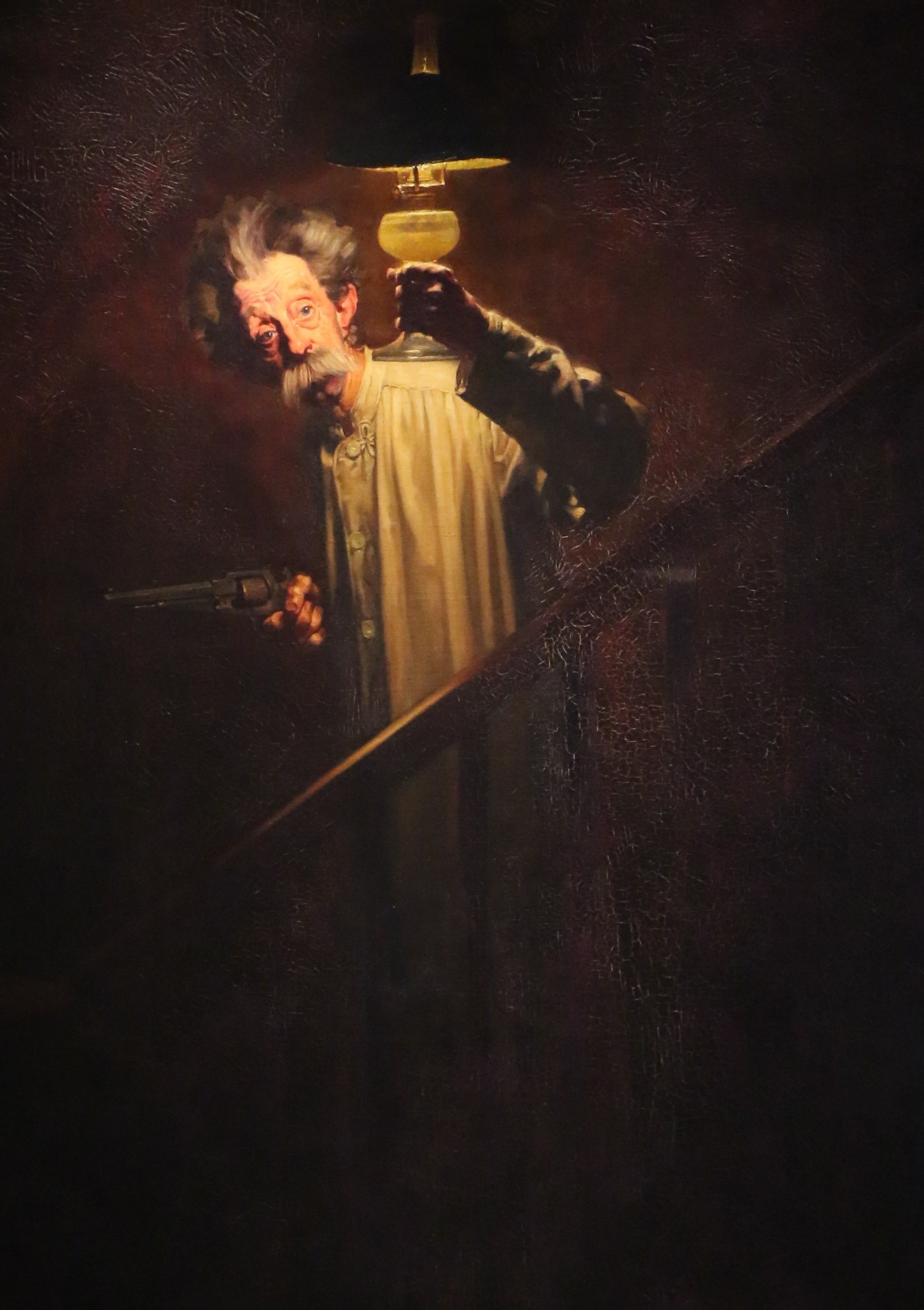
This is from a series of pictures Rockwell did for the Edison Mazda company in the 1920s. They’re among his best pictures from this time period—far better than his much more famous covers for the Saturday Evening Post. (Better than his Post covers from the ’20s.) But they’re not very well known.
This man is holding what looks to be a post-Civil-War-era black powder revolver, not a then-modern high-speed double-action revolver. (He’s not armed with a then-modern high-speed electric light, either. In fact, I’m not entirely sure I understand what makes this a good ad for Edison Mazda, but that’s not quite the point in this article.) This armed citizen is coming downstairs in the middle of the night, presumably to investigate some alarming noise.
Now, the thing that might take a minute to sink in is that Rockwell made this picture as a commercial artist. Apart from the beauty of the image itself—it’s a magnificent picture—the thing that really stands out about it is that this was done as an advertisement for a major national company. And it was simply taken in stride. I’m trying to think of a national, mainstream company that’s not directly involved in making guns and gun paraphernalia using a firearm in an ad campaign in recent years. I’m stumped.
The fact is, people are afraid of guns, and the advertisers who address those people are, consequently, afraid of guns.
How This Affects Kim Rhode’s Visibility
This has all kinds of consequences. Take Kim Rhode, the first woman to medal in six straight Olympics—a person you probably haven’t seen on TV, or heard much talk about. She can’t seem to nail down a non-firearms-related sponsor, despite her amazing career.
The reason for her obscurity and lack of major sponsors is that she’s a skeet shooter. Her sport involves the shotgun. (Discussion. Another discussion. Notice how the article makes it seem as though Rhode had gratuitously introduced her views about the SecondAmendment into the Olympic arena, when in fact the comments the article quotes were responses to direct questions.)
Rhode isn’t your standard Rockwellian gun user: Rockwell’s many guns are almost all in the possession of men. In that sense, Rhode represents one of the gun culture’s most remarkable changes of the last generation or so—the incredible growth of women shooters. As far as I know, Rockwell drew only one woman with a gun.
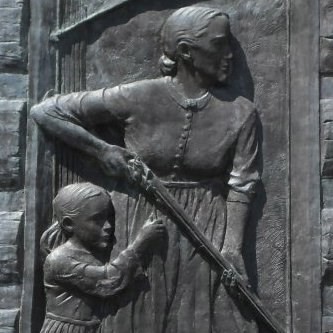
This is actually a Peter Rockwell bronze, but it was a joint effort between Norman and his son, produced for the Cathedral in the Pines in New Hampshire. It’s part of a group of bronzes honoring the contributions of women in war. Norman Rockwell drew the image upon which the bronze is based. It’s obviously a frontier woman preparing to defend her home against an Indian attack. (You can see an arrow in the upper left.)
Like the Edison Mazda ad, this image shows a gun being used in a very grave situation. The woman is resolute—and waiting for her shot. The gun’s not at her shoulder yet. She knows what she’s doing. She’s going to make her shot count. In other words, she’s been well taught. As Rhode points out, though, it’s getting tougher and tougher in many places to teach people about guns.
Rhode lives in California, where Gov. Jerry Brown last month signed six bills that tighten everything from gun ownership to non-owner gun usage to ammunition purchases. Handguns can be lent only to family members and only six times a year, and other guns if “occasional and without regularity.” Large-capacity magazines will be banned, even for competitive shooters.
“They are, in a way, killing my sport, making it more difficult for people to start my sport and try it,” Rhode said. “If I’m going out to coach Boy Scouts or teach somebody how to shoot and I can’t loan them a gun or shell, it becomes very challenging to get new people into the sport.”
If you can only lend guns to a friend “occasionally and without regularity,” you certainly can’t teach her to shoot very well. One would think any proposed law that made it harder to teach people to shoot responsibly and well would be immediately killed. But apparently not.
It’s time to push back, and not with any dark rumblings about “Second Amendment people” or what have you. The best way to push back is to take a kid shooting. Especially a girl. You might be teaching a future Olympian. Or a person who efficaciously refuses to be a victim.
If you’ve been denied an adequate knowledge of firearms so far in your life, start by buying yourself some guns and then taking yourself shooting. (Check here. They’ll teach you right.) Then take a moment to acknowledge the splendid accomplishments of Kim Rhode.









